
Must-Have Flat Towing Components
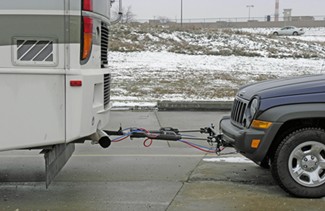
The most common reason for towing a vehicle is basic convenience. Having your everyday vehicle with you means that you don't have to manuever a large, unwieldy motor home through back roads or parking lots when driving to and from your campsite or heading out on errands.
You can use a trailer to tow your vehicle, or a tow dolly, but both of these options take up too much space at campsites and RV parks. A more convenient, space-saving method of towing your car is to use a tow bar. With a tow bar you can easily bring your everyday vehicle with you on your trips, quickly detach once you arrive at your destination, and store the towing system components out of the way until you're ready to hitch up and leave.
There are 5 basic components required to flat tow a vehicle ("dinghy") with an RV or other vehicle ("tow vehicle").
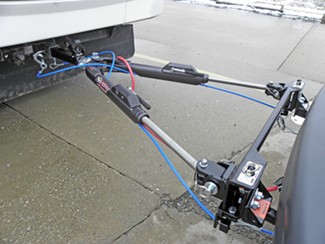
Tow Bar
The tow bar is the most recognizable part of a towing system. It is designed to link your dinghy to your tow vehicle so that it can be safely flat towed. The function of the tow bar is the same regardless of model or manufacturer. The differences lie in the type of mount, towing capacity and basic design.
Beyond those aspects, there are a wide variety of features associated with the various models, all of which are discussed in detail in the Roadmaster Tow Bar Features and the Blue Ox Tow Bar Features.
Mounting Options
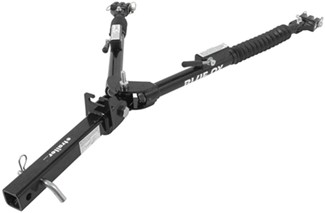 RV-mounted tow bars provide the most reliable, direct connection. Because this
type of tow bar inserts into your motor home's trailer hitch receiver, there is no need for that additional connection point that car-mounted models
require. Not having to use a coupler means that there is one less spot at which your system can become uncoupled. And there is no annoying rattle and play
like you may find with a coupler.
RV-mounted tow bars provide the most reliable, direct connection. Because this
type of tow bar inserts into your motor home's trailer hitch receiver, there is no need for that additional connection point that car-mounted models
require. Not having to use a coupler means that there is one less spot at which your system can become uncoupled. And there is no annoying rattle and play
like you may find with a coupler.
Using a hitch lock you can secure the tow bar to your receiver. And because most RV-mounted tow bars can be safely stored on your motor home when they're not being used, you won't have to worry about packing away your tow system at the campsite.
The benefits of an RV-mounted tow bar include:
- Sturdy, stable connection - no coupler needed
- Safe, secure storage
- Lock tow bar to receiver with hitch lock
- Fold tow bar up and stow it alongside motor home
- Less hassle - no need to remove for storage; no need for separate ball mount and coupler
- Easy to adjust - use a hitch adapter to achieve the rise or drop required to match your dinghy's height
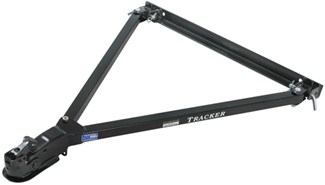 Car-mounted tow bars were the first introduced to the towing and RVing market.
They function the same as an A-frame trailer, attaching to the trailer hitch ball on your RV with an integrated coupler.
Car-mounted tow bars were the first introduced to the towing and RVing market.
They function the same as an A-frame trailer, attaching to the trailer hitch ball on your RV with an integrated coupler.
The benefits of a car-mounted tow bar include:
- Economical models are made for occasional RVers
- Integrated coupler can be locked to hitch ball for security
- Couplers for 2" and 2-5/16" balls, as well as pintle hitches, are available
Design and Structure
The design and structure of tow bars varies between manufacturers. The basic configuration, though, is similar to that of an A-frame trailer. The tow bar attaches to your dinghy at the ends of the tow bar arms. The other end of the bar then hitches up to your tow vehicle via either an integrated coupler or by means of a receiver mount.
- Crossbar vs. Hidden Brackets
- Some tow bars include a crossbar that mounts between the arms near the connection point between your tow bar and dinghy. This is designed to lend extra support for your towing system.
- Not all tow bars require this additional support. Some base plate kits are made to attach to your dinghy's frame in such a way as to provide enough support for it to be towed without the aid of a crossbar.
- Fixed vs. Telescoping Arms
- Some economical, car-mount tow bars are made with rigid arms that do not adjust.
- Tow bars with adjustable arms are easier to hook up. You do not have to drive your dinghy into an exact position to connect your towing system rather; you pull the telescoping arm out, or push it back in, to get the length you need.
Extra Features of Tow Bars:
- Non-binding release latches
- Hassle-free disconnect, even on unlevel ground
- Self-aligning arms
- Telescope to make hookup a breeze
- Automatically center and lock when pulling away
- Aluminum construction instead of steel
- Lightweight for an easy-to handle, simple-to-store tow bar
- Pivot joints
- Allows arms of tow bar to pivot and adjust for quick, simple hookup on unlevel ground
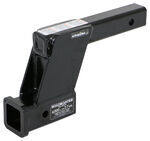
High/Low Adapters
When your dinghy is connected to your motorhome, the tow bar should be within 3" of level. If it is not within this acceptable range of level, you will need to use a high/low adapter to properly connect up. Click here to learn more about high/low adapters.
Base Plate Kits
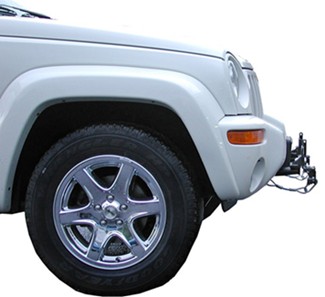
Base plates are the only piece of the puzzle that is vehicle specific. A vehicle that is being towed requires custom-designed base plates that specifically fit its frame. Once installed on your car's frame, the base plates provide attachment points for your tow bar.
Base plates install on your dinghy's frame using as many existing attachment points as possible without sacrificing strength or safety. When multiple base plate kits are available for a specific vehicle, installation will be nearly the same for each kit. The differences lie in the draw bar type and the number of frame bracket pieces. Typically, base plates consist of two main parts:
- Frame bracket(s)
- Mount directly to the dinghy's frame
- Draw bar arms provide attachment points for the tow bar.
- Removable arms
- Attach to the frame brackets using a pin and clip or twist-lock feature
- Create cleaner look with no visible brackets
- Fixed arms
- Welded to the frame bracket
- Visible at all times
- Typically, more economical option
- Removable arms
Roadmaster offers four different styles of base plates. To see a detailed overview of Roadmaster base plates, click here. Blue Ox only offers one type of base plate. To learn more about their lug-style attachment system, click here.
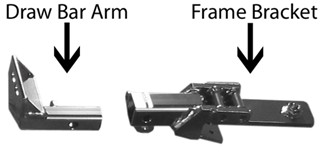
Base Plate Adapters
While most base plate manufacturers try to construct products to fit as many applications as possible, it is not uncommon to find that the company that made your tow bar does not have base plates for your vehicle. If you have a tow bar and base plates that are manufactured by different companies, you will need to purchase an adapter.
Why are adapters necessary?
Each tow bar manufacturer has a unique type of connection that is used to secure the tow bar to the base plate arms.
Roadmaster base plates
Most Roadmaster tow bars and base plates use quick disconnects to attach the base plates to the crossbar and tow bar.
- One quick-disconnect bracket attaches to the tow bar arm or the crossbar
- Other quick-disconnect bracket attaches to the base plate draw bar arm
- Both brackets then interlock with one another and are secured together with a linch pin
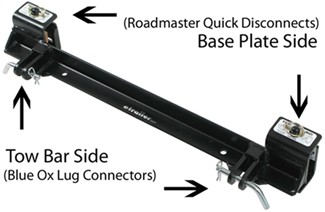
Blue Ox base plates
The draw bar arms have two lugs that interlock with the lugs on the ends of the tow bar arms and then secure in place with a pin and clip.
Demco
The draw bar arms have two-prong ends that slide around the tow bar arm extensions and secure in place using a pin and clip.
So...
If you have a Blue Ox tow bar, but you only have Roadmaster base plates with quick disconnects, then the Blue Ox triple-lug ends on the tow bar arms will not work with your base plates. The adapter you need will have one side that connects with the lugs on the Blue Ox tow bar and one side that has quick disconnects for use with Roadmaster base plates.
If you need an adapter, but aren't sure which type, consult the table here to help you choose.
Safety Cables
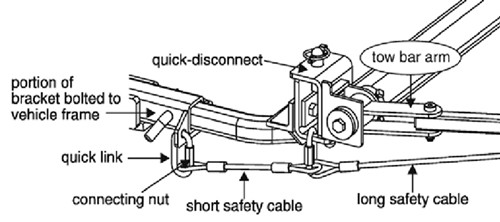
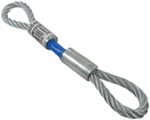
Safety cables are crucial for any tow bar setup and are required by law in most states. They ensure that your dinghy does not detach from your RV in the event that your tow bar somehow uncouples from it, or that your dinghy uncouples from your tow bar.
In most towing setups, safety cables link two or three components together:
- The long cable connects the RV hitch to the base plate arms on the dinghy
- The small cable connects the base plate arms to the frame-mounted brackets on the dinghy
Long, straight cables
- Designed for tow bars that have integrated cable channels
- Note: Cables should not be wrapped around Blue Ox tow bars with protective rubber boots.

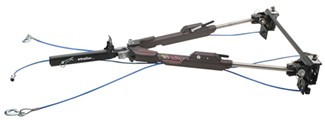
Long, coiled cables
- Won't drag during towing
- Note: Do not use coiled cables with tow bars that have safety cable channels.
Short safety cables
- Required when using the Roadmaster EZ or XL base plates
- Connect removable draw bar arms to base plate brackets
- Designed to hold your tow system in place if the draw bar arms become disconnected from the dinghy's frame brackets
Tow Bar Wiring
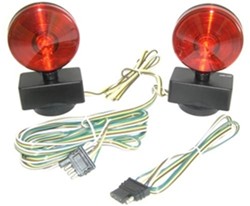
You are required by law to have a lighting system on your dinghy that functions in sync with your tow vehicle's tail lights.
Removable exterior light kits
- Magnetic towing lights
- Hitch-mounted light bar
Separate tail light bulb kits
- Mounts inside vehicle's tail light housing
- Bypasses dinghy lighting system
Diode light systems
- Wires in-line with dinghy's existing tail light bulbs
- Requires little to no maintenance after initial installation
Wiring extensions
- Connect towed vehicle wiring to motorhome wiring
- Most installations require an extension
Charge line kits
- Allows RV or motorhome to charge towed vehicle's battery while towing
- Connects from 6-way or 7-way plug at front of towed vehicle to it's battery
- Keeps towed vehicle's battery charged if that battery is used for powering a braking system
- A power line must be present on the RV or motorhome
- If power is not at the 6-way or 7-way plug on the RV or motorhome, then a charge line kit made for RVs and motorhomes must be installed
For detailed information on the types of dinghy lighting available, click here.
Supplemental Braking Systems
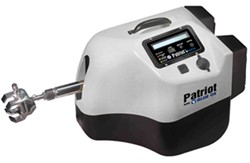
- Required in most states and Canadian provinces
- Can decrease braking distance up to 30 percent on some towing setups
- Minimizes wear on both vehicles and smoothes braking
- Maintains RV warranty
- Many RV manufacturers will only honor your warranty if a braking system is in place when towing
For more information on supplemental braking systems, click here.
General Setup Tips
Before deciding on a tow system:
Be sure that your dinghy can be towed before taking it on the road. Some vehicles must be equipped with a transmission lube pump, an axle disconnect, a drive-line disconnect or free-wheeling hubs before they can be towed with a tow bar. Failure to properly equip your vehicle could lead to severe damage to its transmission. Check your owner's manual or call your dealer for specific information on your vehicle.
If your vehicle cannot be towed for any of the above reasons, you may be able to use a tow dolly instead.
Initial setup
- Never exceed the maximum weight capacity of your tow bar, or of any other component of your towing system
- Always hook up on level ground - even non-binding tow bars may be difficult to maneuver if your system is not in line
- Set your dinghy's steering and transmission to "tow"
- Check to make sure tow bar arms are locked in place before heading out
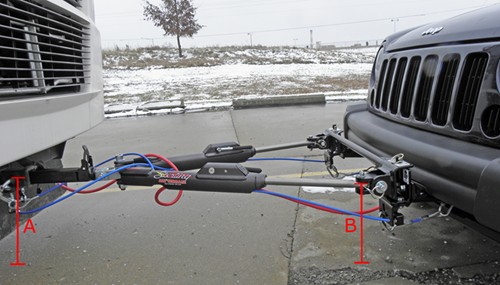
Towing tips
Ensure that your tow bar setup is as level as possible, from the hitch of the tow vehicle to the base plates of the dinghy.
- Improper leverage on the RV and dinghy can cause stress and wear on the tow bar as well as the base plates
- When braking, stress is applied to your towing system and to the frames of both your RV and dinghy as a result of the downward braking force placed on the fronts of both vehicles. This can cause flexing at the base plate installation points and adversely affect both the frame and suspension of your towed vehicle.
The end of the tow bar that attaches to the base plates should not exceed a rise or drop of 3 inches from the center of the RV hitch receiver
- A Measure the height from the center of your hitch pin hole on the RV to the ground
- B Measure the distance from the center of your dinghy's draw bar arms (when installed in frame brackets) to the ground
- Subtract the difference C = A - B
- If there is more than a 3 inch difference, higher or lower, a hitch adapter is needed.
Safety cable tips
- Cross your safety cables under the coupler of your tow bar as an extra safety measure
- Prevents the front of the tow bar from dragging in the event of a disconnect
- If the tow bar were to hit the ground during a disconnect, it could cause the dinghy to jackknife into the tow vehicle.
- Prevents the front of the tow bar from dragging in the event of a disconnect
- Use quick links
- Place quick links on the RV's hitch and the dinghy's base plates to make clipping on safety cables quick and easy
- No awkward hookups; just a clip that attaches to the cable hook
Updated by: Raymond P.
Last updated: 7/3/18
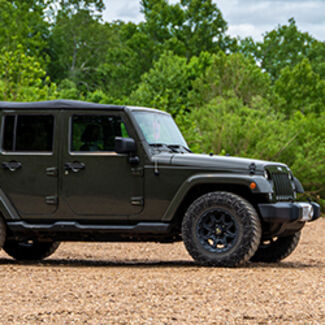
Chris L.
1/20/2023
We have a 2002 Jeep Liberty 4x4 for a toad behind our Toyota Tundra 4x4 with a Lance 825 truck camper. We have a blue ox flat towing system. Even before adding the ( supplemental) Brake buddy we didn’t feel it back there. The Liberty has a 5 position transfer case, 2 wheel,4 part time, 4 full time, neutral & 4low. It’s an excellent lighter weight toad.

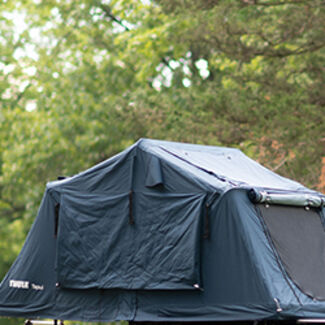
Becky W.
7/28/2022
We are thinking of purchasing a 22 Chevy Colorado and want to know if it can be towed by our Winnebago Itasca Class A motorhome?


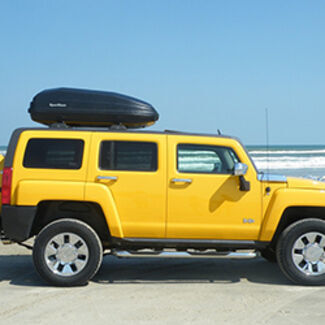
Kerry S.
11/14/2021
How much does it typically cost to properly set up a tow vehicle by a professional?

Departments
Towing
- Trailer Hitch
- Fifth Wheel
- Gooseneck
- Towing a Vehicle
- Front Hitch
- RV Hitch
- ATV Hitch
- HD Truck Hitch
- Vehicle Wiring
- Brake Controller
- Ball Mounts
- Weight Distribution
Sports and Recreation
Trailer Parts
- Utility Trailer
- Boat Trailer
- Landscape Trailer
- Enclosed Trailer
- 5th/Camper Trailer
- Car Hauler
- Horse Trailer
Vehicle
Contact & Help

What our customers are saying:
"Quick processing, and delivery. reasonably priced very satisfied"
Popular Vehicles
- Subaru Forester
- Ford F-350 Super Duty
- Ford F-250 Super Duty
- Chevrolet Silverado 1500
- Jeep Wrangler Unlimited
- Jeep Wrangler
- Ram 3500
- Toyota Highlander
- Ram 2500
- Chevrolet Silverado 2500
- Subaru Outback Wagon
- Chevrolet Silverado
- Dodge Ram Pickup
- GMC Sierra 2500
- Ram 1500
- Ford F-250 and F-350 Super Duty
- Jeep Grand Cherokee
- Toyota Tacoma
- GMC Sierra 3500
- Toyota Tundra
- Ford Escape
- More >>



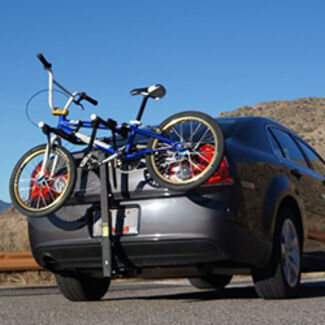

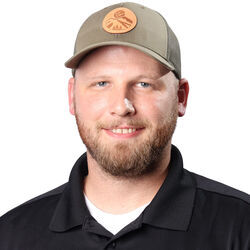



























Troy
5/4/2023
Can I flat tow my hotwheels?